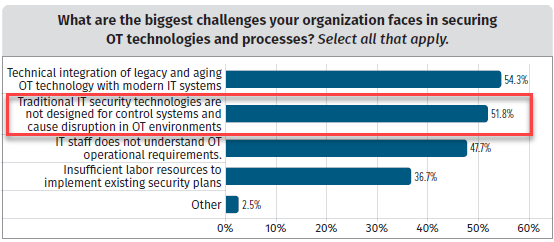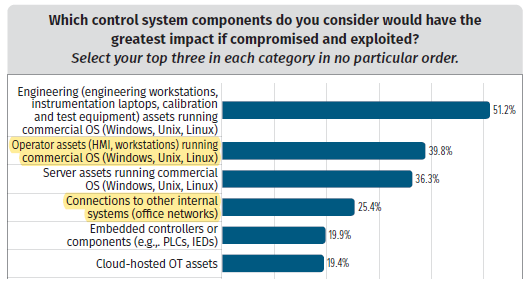ICS/OT Practitioners Share Their Unique Requirements & Concerns
SANS released its annual ‘State of ICS/OT Cybersecurity’ report in October 2022. It reflects survey results from 332 ICS/OT organizations representing a range of industrial verticals.
According to respondents, their 2nd biggest challenge in securing OT technologies and processes is that “traditional IT security technologies are not designed for ICS and cause disruption in OT environments.” [1] That certainly applies to Secure Remote Access for ICS/OT, the application for which XONA Systems has created a purpose-built solution.

Figure 3. Biggest Challenges in Security OT Technologies and Processes
This viewpoint is not surprising. In February 2022, SANS created an infographic[2] that cited the differences between cybersecurity for ICS/OT and IT environments. It offered guidance on defining the differences between cybersecurity defense methodologies, security controls, safety, impacts, skill sets, and the security missions for ICS/OT versus IT.
One example cited was the (likely) application of a popular remote access and control program named TeamViewer as the vehicle that unidentified cyber actors employed to compromise a U.S. Water Treatment facility.[3] TeamViewer is widely used in traditional IT environments to enable IT personnel to install/update software on a computer where administrative rights are withheld from the end-user out of security concerns.
Another challenge, according to SANS, is that “ICS/OT assets are often compared to traditional IT assets; however, traditional IT assets focus on data at rest or data in transit, while ICS/OT systems monitor and manage data that makes real-time changes in the real world with physical inputs and controlled physical actions.” As such, ICS/OT cybersecurity must support the safe operation of critical infrastructure, not the other way around.
Other findings:
- A compromise in IT is the #1 (40.8%) initial attack vector allowing threats into OT/ICS networks.
- Lowering risk/improving security and preventing information leakage are the #1 (53.6%) and #4 (29.1%) OT/ICS business concerns.
- Operator assets, such as a human-machine interface (HMI) or operator workstations, are considered one of the control system components at greatest risk (#2 at 43% – up from 32% in 2021) and one of the control system components with the greatest (negative) impact if compromised and exploited (also #2 at 39.8%).

- Once safety risks and operational impacts from a cyberattack are seen, it’s too late.
Of note is the viewpoint that “ICS security is not a ‘copy/paste’ of IT security. That there’s a misconception that IT security practices can be directly applied to ICS environments.” Although a wealth of knowledge is available from IT security, a “copy and paste” of IT security tools, processes, and best practices into an ICS could have problematic or devastating impacts on production and safety.
References:
- SANS – The State of ICS/OT Cybersecurity in 2022 and Beyond (Dean Parsons, OCT 2022) ↑
- The Differences Between ICS/OT and IT Security Poster | SANS Institute ↑
- Compromise of U.S. Water Treatment Facility | CISA ↑
